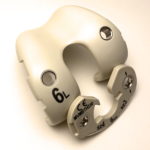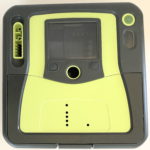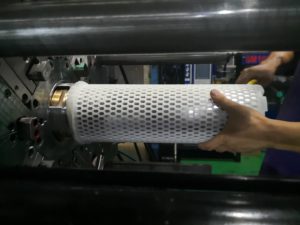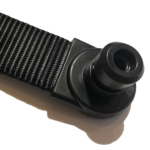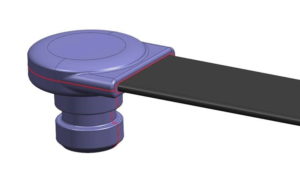Insert and Overmolding Processes
Insert molding and overmolding combine multiple components into a single assembled part during the plastic injection molding process. In these variations preformed components are placed into the mold tool and then captured and joined into a single combined part as new plastic geometry is molded over them.
A wide variety of materials such as metal hardware, plastics and fabrics are commonly used across an extensive range of molding applications today. In particular, these types of processes enable design freedom and improved part performance in molded parts that otherwise would be cost prohibitive or impossible.
Generally insert molding and overmolding are differentiated by the materials being used. Overmolding is typically defined as plastic over plastic, while plastic over metal, or another material, is generally referred to as insert molding. Although the terms can be used in various ways for certain applications.
Additionally, these processes can be combined. For instance plastic can be molded over plastic that has already been molded over plastic. Plastic also can be overmolded over plastic that as already had metal insert molded into it. Another application may call for two materials, e.g. metal and rubber, to be insert molded into plastic at the same time.
All of these different processes can be mixed depending on the application and creativity of the design.
Insert Molding
Insert molding is used on applications like handles and grips because they require a high level of aesthetic and tactile focus due to the amount of interaction with end users. Designers can enhance the ergonomics and feel of these components by overmolding them with soft elastomeric materials known as Thermoplastic Elastomers or TPEs. These polymers come in a variety of material types and durometers so the overmold material can be tailored to a specific set of product requirements.
Many medical tools that require sterilization further benefit from this process by creating tight seals around instrument substrates and handle shafts. This helps to prevent areas for bacteria to collect and ensures the sterilization process is effective between procedures.
Mechanical hardware is another common application benefitting from insert molding. By placing and capturing items like threaded inserts, pins, bushings, etc. in the tool before injecting the plastic, it is possible to mold around these components to mechanically capture the hardware into the molded part. In most cases this replaces secondary hardware installation processes accomplished via bonding, ultrasonics or thermal insertion. Depending on the application and volumes of the product, this could yield cost savings and increase manufacturing throughput.
By comparison, thermal and ultrasonic hardware installation post molding can reduce the mechanical retention of the insert in the part. These processes locally heat the plastic and flow it around rib and knurled geometry in the hardware to create mechanical retention. Inserts designed for insert molding utilize much more significant retention features as the molding process can fully pack material around the body of the insert to achieve much higher strength ratings for insert molded components.
Overmolding
In some cases a part can be progressively overmolded in a series of tools to build plastic thicknesses that would be impossible to mold in a single shot. This allows for parts with extreme thick, thin or other detailed geometry to be produced for ergonomic and aesthetic purposes. Soft gasket features can also be molded into sealing glands so critical sealing geometry is permanently captured in place.
The types of components that can to be overmolded to incorporate features in parts include a wide variety of materials and design opportunities. Common examples include clear windows, decorative features (IMD), electronics and magnets.
The fundamentals for overmolding a component are the same in all cases. The design of the components needs to consider several process-related factors such as tooling and material compatibility. As a prerequisite, the substrate material getting overmolded needs to be robust enough to survive the injection molding process where it will be exposed to high heat and extreme pressures as molten plastic flows past it.
When an insert gets overmolded the bond between the two needs to survive the end application requirements. This can be accomplished through a mechanical interlock or with a chemical bond.
The mechanical method is achieved by making sure the substrate has undercuts or pass through features to allow the overmold material to fill and hold the component in place. If the part will experience mechanical stresses the retention features should be designed to take this into account to avoid overmold separation.
Alternatively it can also be possible to achieve a chemical bond between substrate and overmold. This method is typically only viable if the substrate is also a plastic material. By selecting substrate and overmold materials that are compatible it is possible to form chemical bonds during overmolding that will entirely lock the overmold in place over the substrate. In some cases resins will be specifically rated to bond with particular substrate materials, especially when working with TPEs.
It is also possible to promote bonding by prepping the substrate surface with primers, etching chemicals or plasma treatment.
Tool Design Considerations
Tool design for an overmold has several specific requirements the part design should consider. When an operator or robot places an insert or substrate into the overmold tool it needs to be located successfully and held sufficiently while the tool closes, as well as during the injection molding process where high pressures can be working to shift the substrate out of place. This is critical because failure can result in scrap parts or even tool damage that is often lengthy and expensive to repair.
Plastic substrates can be shifted or easily deformed by overmolding pressures if not supported properly. To accomplish this the tool needs to be designed with geometry that captures the insert. This is most often done with features in the tool steel that the insert can be placed onto and clamped against as the tool closes. Designers need to be aware of this because these support locations will prevent overmold material from flowing into these areas, meaning they will be exposed in the resulting part. Care should be taken to design adequate support features in the substrate that are either hidden or functional in the component.
It is also critical the seams between the overmold and insert or substrate are designed so the tool steel can successfully shutoff against the substrate to prevent overmold material from flashing outside of the intended geometry. Shutoffs are best made when the action of the tool closing can create a small amount of preload or crush on the part to successfully seal the overmold cavity. When the overmold parting line is more dynamic, special attention must be given to the shutoff geometry and substrate support in the tool to prevent flash from occurring.
Overmolding and insert molding offer creative opportunities to get innovative with new part designs. If you have a part design that could be insert or overmolded please consider reaching out to Mack Molding to get feedback on the design and cost of your product. Mack has experience with hundreds of overmolded product in its portfolio to guide you in the right direction.
